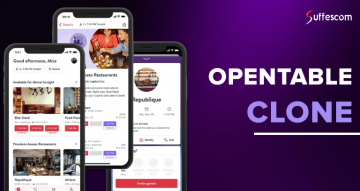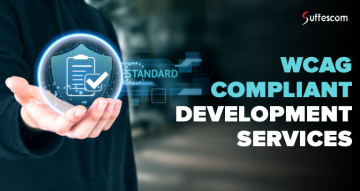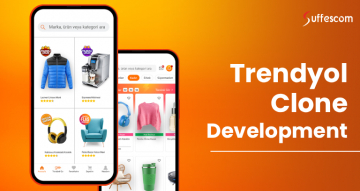Affordable Addiction Recovery Mobile App Development For Future of Sobriety

The addiction recovery process is challenging due to the limited access to services and resources. With the rapid evolution of technology, addiction recovery applications are emerging as an essential tool in the path of recovery.
Since the market is trending, it is high time to invest in an addiction recovery app development. Without careful research and planning, the investment and efforts would go down the drain, resulting in unsatisfactory results.
A study by UT Health San Antonio involving 600 participants with opioid use disorder demonstrated that users of the WEconnect Health app, combined with medication, reduced opioid use by 35% and remained in treatment 19% longer than those using only medication.
This positive change states the importance of developing and launching a promising addiction recovery app. Read the blog and know the essential information about developing an addiction recovery application.
Partner with Us for Addiction Recovery App Development
Suffescom Solutions drive a transformative change in the U.S. healthcare landscape using our expert addiction recovery app development solutions. Leverage our extensive industry expertise and position your business as a major player in healthcare.
Understanding the Addiction Recovery App
As their name suggests, these apps help users to recover from their addictions, ranging from drugs to social media. An addiction recovery app plays various roles for the users. They are a guardian, mentor, friend, and a cheerleader, designed to let the users overcome their addictions.
Essential Features of Addiction Recovery App
Addiction recovery apps offer various features, from tracking progress and providing educational resources to connecting users with professional counselors.
User Privacy
It needs no emphasis to state that user privacy is essential. Users sign up for the application with trust; hence, addiction recovery app development equips robust mechanisms to protect users' privacy.
The app secures user information using OAuth 2.0, Multi-Factor Authentication (MFA), Role-Based Access Control (RBAC), and Data Anonymization & Masking.
Intuitive UI
The addiction recovery application is designed with an intuitive UI to enhance the user experience using Figma, Adobe XD, React Native, Flutter, and Ant Design. The intuitive UI provides users simple navigation, easy-to-operate controls, and an attractive layout.
Reminders & Notifications
Addiction recovery development has made it easier for users to track their daily activities, journeys, and mood swings. The application is integrated with a daily reminder tool to update users on their performance and help them spot behaviour changes.
What tools provide timely reminders and notifications? These are Android AlarmManager, iOS UNNotificationRequest, WorkManager (Android), BackgroundTasks (iOS), and Firebase Cloud Functions.
Educational Content & Resources
The drug recovery application offers users different educational content, such as articles, audio, and videos. It is a valuable tool that aims to provide users with important information, such as scientific methods to cope with drug abuse.
Educating users about such content can assist in promoting awareness among users and can help them make better decisions. Addiction recovery app development equips CMS platforms, media players, and hosting services for effective, timely content delivery.
Community and Peer Support
Addiction recovery applications enable users to interact with each other. This fosters a sense of community among the users, who can support each other. Real-time chat tools and forum/group APIs allow users to connect through discussion forums, chat rooms, or peer support networks.
Coping Exercises and Sessions
Addiction recovery applications offer users different meditation sessions, breathing exercises, and interactive cognitive-behavioural exercises. These activities help users tackle stress, handle cravings, and manage mood swings. This will support users emotionally and promote overall happiness.
Personal Journaling
A personal journal lets users write down their emotions, feelings, and experiences, which is highly therapeutic. Sharing emotions also aids users in self-reflecting on their actions and assists in identifying triggers and coping strategies.
Goal Setting
To develop an addiction recovery app, the systems must enable users to set a goal or purpose. Users can select if they're going to cure substance abuse, social media usage, improve mental health, or learn healthy habits.
Users can also track their progress and activities over time, enabled by goal tracker modules and progress tracker libraries.
Data Analysis and Insights
The drug recovery application incorporates data analytical tools to analyze the data collected from user input. The addiction recovery app presents the information using progress reports, insights, and visualizations, using data visualization tools such as Chart.js and analytics tools like Firebase analytics. It also allows users to identify the issues and adopt the correct coping technique.
Integration with External Services
Using third-party API integrations and OpenID Connect, addiction recovery applications easily integrate with external services such as treatment centres, therapists, or support group directories. Users can easily access these resources throughout the recovery process.
Apart from integration with external services, a reliable addiction recovery app integrates with complementary solutions such as mental health therapy apps or wellness apps.
Real-Time Support Chat
To start an addiction recovery app, the team implements an NLP-driven chatbot to offer real-time support to users. AI chatbots can help users connect with peers who are facing similar issues.
Advanced Features of a Professional Addiction Recovery App
Incorporating basic features in an addiction recovery app is necessary to enter the market, but to survive in a cut-throat competition, the app must have advanced features. Let's see what some of those features are-
1. Personalized AI Guidance
This feature helps learn about users' habits, progress, and requirements to offer tailored advice and recovery tips. Personalized AI guidance delivers higher engagement and improved outcomes.
How does this feature benefit app owners? First, it gives them a competitive edge by delivering personalized features. Second, it increases user retention. Third, it provides actionable insights.
Here's the tech stack that incorporates personalized AI guidance in an addiction recovery application
1. Machine Learning Frameworks: TensorFlow, PyTorch, or scikit-learn to build predictive and recommendation models.
2. Data Analytics: Python with libraries like Pandas and NumPy for data processing.
3. APIs: Custom or third-party recommendation engines for integration with the app.
2. NLP-Based Chat Support
Natural language processing (NLP) helps understand users' messages using NLP libraries and frameworks for assistance and support. Along with delivering constant and standardized support, NLP-enabled chat support systems increase scalability by handling multiple conversations using chatbot platforms and deep learning models.
Benefits of incorporating the feature-
1. Cost-efficiency: Does not require a dedicated customer support team.
2. Increase in user experience: Fast and correct responses increase consumer satisfaction.
3. Provision of data collection: Data collected from chatbot conversions helps create business strategies.
Voice Recognition
Voice recognition technology uses the voice pattern to assess the user's stress level. This feature is extremely useful for users who have difficulty typing and stating the problem verbally. Voice recognition technology improves user engagement due to more seamless operations.
It expands the market as new users are on boarded and improves interaction for more accurate data collection and personalized support.
3. Behavioral Pattern Recognition
Behavioral pattern recognition analyzes user behaviour on various metrics such as app usage, mood logs, prompt responses, etc. This analysis detects patterns that state risks or progresses in recovery.
The first advantage for the user is proactive interventions. These interventions identify when a user needs support before a crisis occurs by identifying user behavior.
The following tech stack and tools are used in incorporating this feature-
1. Data Analytics Platforms: Tools like Apache Spark or cloud-based analytics (AWS, Google BigQuery) for handling and analyzing large datasets.
2. Machine Learning Algorithms: Techniques such as clustering and anomaly detection implemented in Python to recognize patterns.
3. Visualization Tools: Libraries like D3.js or Tableau to present behavior trends in a user-friendly format.
4. Wearable Tech Integration
This feature connects the app with wearable devices (like smartwatches or fitness bands) to collect data such as heart rate, sleep patterns, or physical activity. This data helps provide a holistic view of the user's recovery journey.
1. Continuous Monitoring: Provides real-time health and activity data without extra effort from the user.
2. Comprehensive Data: Combines physical health metrics with behavioral data from the app for better insights.
3. Proactive Health Management: Enables timely interventions based on physiological changes (e.g., stress spikes).
4. Enhanced User Engagement: Provides more value to users by linking physical health with recovery progress.
5. Improved Personalization: More data means better-tailored advice and interventions.
6. Market Differentiation: Offering integrated wearable tech sets the app apart from competitors, potentially increasing market share.
Develop an Addiction Recovery App in No Time!
Seize a strategic edge in healthcare innovation. Partner with us to swiftly develop a cutting-edge addiction recovery app and capture the growing demand in the US market.
The Process to Develop an Addiction Recovery App
Setting up a standardized process to start an addiction recovery app is essential to achieve the desired results. The following steps to build an addiction app hint at the ideal method, which ensures desired results-
Step 1 - Market Research
Market research sets the path for a successful and focused journey to develop an addiction recovery app. The step includes collecting information about potential users, competitors, and industry trends to understand what people need and what competitors are offering.
How to do it?
- Using online surveys, focus groups, and interviews with potential users.
- Competitor research using websites, reviews, and app features.
- Analyze industry reports and trends related to addiction recovery.
Essential processes, methods, and tech stack
- Processes: Data collection & analysis, competitor analysis, user persona creation.
- Methods: Surveys using tools like SurveyMonkey, interviews, and social media listening.
- Tech Stack: Data analysis software, e.g., Google Analytics, Excel, and CRM tools for managing research data.
Why research the market? What are the benefits?
- To identify market gaps and validate your app idea.
- Benefits: Helps tailor the app to real user needs, reduces risks, and sets a clear direction for development.
Effective marketing research practices
- Use reliable sources and keep updated on trends.
- Document all findings clearly to refer back during planning.
How does market research help in strategy formulation?
- The insights from market research directly influence the strategy planning phase, ensuring that your app's goals and features align with actual market demands.
Step 2 - Planning a Strategy
The information from market research is the foundation of strategy and planning. Basically, strategy includes a detailed framework for the upcoming step in the addiction recovery app development process.
A strategy plan includes the app’s objectives, target audience, app features, competitive strategy, and market positioning.
How to formulate a strategy?
- By defining clear objectives and targeting user groups based on research findings.
- Creating a roadmap including key features, timelines, and resource allocation.
Essential processes, methods, and tech stack
- Processes: Goal setting, roadmap creation, risk assessment.
- Methods: SWOT analysis, user journey mapping, brainstorming sessions.
- Tech Stack: Project management tools like Trello and flowchart tools like Lucidchart.
Why create a strategy?
- To have a well-defined plan that minimizes risks and aligns the team.
- Strategy provides direction, helps prioritize tasks, ensures efficient use of resources, and sets clear milestones.
Effective practices in planning and strategizing
- Keep the strategy flexible to adapt to unforeseen challenges or insights.
- Regularly review and update the strategy as needed.
How does strategizing help in UI/UX design?
- Strategizing aids in creating a blueprint for UI/UX design and ensures that design decisions align with your overall goals and user expectations.
Step 3 - UI/UX Design
It is time to decide your app's visual appeal (UI) and navigation usability (UX). This is a step where the app idea takes a shape.
How to do it?
- Rough layouts and wireframes to outline the basic app structure.
- Create detailed mockups and prototypes.
Essential processes, methods, and tech stack
- Processes: Wireframing, prototyping, user testing.
- Methods: User journey mapping, iterative design, A/B testing for interfaces.
- Tech Stack: Design tools like Sketch, Adobe XD, Figma, or InVision; prototyping and testing tools.
Why do it? What are the benefits?
- To make the app intuitive and engaging so users can navigate easily.
- Enhances user satisfaction, reduces confusion, and increases app usage and retention.
Effective UI/UX design practices
- Gather early feedback by testing prototypes with real users.
- Focus on accessibility and clear navigation paths.
- Iterate quickly based on user feedback.
How does UI/UX design help with development?
- A well-designed UI/UX ensures that developers have clear, user-friendly guidelines during development, reducing back-and-forth and rework.
Step 4 - App Development
Development is writing the code and building the app based on the design and strategic plan.
How to do it?
- Project breakdown into smaller tasks for front-end, back-end, and integration.
- Code the features, integrate APIs, and build the database.
Essential processes, methods, and tech stack
- Processes: Agile development, continuous integration/continuous deployment (CI/CD), version control.
- Methods: Code reviews, iterative builds, and sprint planning.
Tech Stack:
- Front-end: Frameworks like React Native or Flutter for mobile apps.
- Back-end: Node.js, Python (Django/Flask), or Ruby on Rails.
- Database: PostgreSQL, MySQL, or MongoDB.
- Tools: Git, Docker, Jenkins, or other CI/CD tools.
Effective development practices
- Implement agile methodologies to iterate quickly.
- Use version control to maintain code integrity.
- Conduct regular code reviews and unit tests.
How does it help with testing?
- A stable, functional app provides a solid base for thorough testing, essential to ensure that all features work as intended and meet quality standards.
Step 5 - Testing
Testing holds immense importance in ensuring that the application runs spick and span. Under this step, the testing team checks for bugs or issues in the application before launching it in the market.
How to do it?
- Performing functional, performance, security, and usability tests.
- Use automated testing tools alongside manual testing techniques.
Essential processes, methods, and tech stack
- Processes: Unit testing, integration testing, system testing, and user acceptance testing (UAT).
- Methods: Regression testing, A/B testing for changes, load and stress testing.
- Tech Stack: Testing frameworks (e.g., Jest, Selenium, Appium), as well as bug tracking tools like JIRA.
Why do it? What are the benefits?
- To catch errors, ensure stability, and improve user satisfaction by providing a smooth experience.
- Helps avoid costly errors post-launch, improves app performance, and ensures a secure and reliable product.
Effective testing practices
- Automate repetitive tests to save time.
- Involve real users for beta testing to gather genuine feedback.
- Document issues and fixes clearly for continuous improvement.
How does testing help with launch & deployment?
- Thorough testing ensures that when you launch the app, you have a reliable and efficient product that generates positive user experiences, ultimately setting the stage for a successful deployment.
Step 6 - Launch and Deployment
Release your app to the public and make it available on app stores or other platforms.
How to do it?
- Prepare a launch plan including marketing and support strategies.
- Deploy the app using cloud services.
Essential processes, methods, and tech stack
- Processes: Final quality assurance, staging environment testing, marketing rollout.
- Methods: Soft launches for small user groups, feedback collection, and phased rollouts.
- Tech Stack: Cloud hosting services (e.g., AWS, Azure), containerization (e.g., Docker), mobile app distribution platforms (Google Play, Apple App Store).
Why do it? What are the benefits?
- To get your product into the hands of users and start making a real impact.
- Direct user feedback, early revenue generation, and opportunities for rapid iteration based on market response.
Effective launch and deployment practices
- Monitor performance and gather user feedback immediately post-launch.
- Have a support system ready to handle issues and update the app.
- Use marketing tools and analytics to track engagement and drive growth.
How does it help with post-launch support?
- A successful launch sets a strong foundation for continuous improvement. Feedback from real users guides future updates, creating a loop of ongoing refinement and enhanced user satisfaction.
Top-Notch Addiction Recovery App Development Services
If all you are looking for is the assistance of a promising addiction recovery app development service, then Suffescom Solutions is the ideal choice. Shake hands with us and launch a scalable solution.
What is the Cost of Starting an Addiction Recovery App?
The cost to develop an addiction recovery app ranges between $8000 and $15000. Check out the following cost breakdown for complete understanding-
| Development Step | Estimated Cost Range ($) | Major Cost Factors |
Market Research Planning a Strategy | Free Consultation | Target audience surveys Feature road-map Monetization model Regulatory considerations (HIPAA, etc.) MVP vs. full version |
| UI/UX Design | $1600 - $3000 | Custom UI/UX designs Accessibility features Branding requirements Number of screens |
| App Development | $5600 - $10500 | Platform (iOS/Android or hybrid) Core features (chat, progress tracker, reminders) Backend setup |
| Testing | $600 - $1000 | Manual and automated testing Cross-platform compatibility Security testing |
| Launch & Deployment | $200 - $500 | App store optimization (ASO) Cloud hosting setup Submission and compliance costs |
How to Ensure Returns Against Addiction Recovery App Development?
Develop an addiction recovery app and earn by opting for various revenue models. Here's the list:
1. In-app advertising: Charge a fee for promoting products on the application.
2. Subscription fees: Offer weekly, monthly, or yearly plans to access the other content or features.
3. In-app purchases: Customers can purchase additional services, content, or features within an application.
4. Affiliate marketing: Earn referral fees by partnering with rehabilitation centers, therapists, or health care providers.
5. Anonymous data monetization: Aggregate and anonymize user data for researchers, non-profit organizations, or policy makers.
Please note that these revenue models broadly apply to healthcare app development, on-demand app development, and various others.
Conclusion
Now that you understand everything essential about addiction recovery app development, delivering a market-ready and scalable solution is a no-brainer. To cut it short, and ensure quick entry into the market, get in touch with a reliable and affordable app development company like Suffescom Solutions.
Looking forward to starting an online drug rehab business using a scalable application? Then Suffescom Solutions is the ideal choice. With more than 13 years of experience delivering custom application development solutions, Suffescom has served various businesses in multiple industries.
FAQs
How much does it take to develop an addiction recovery app?
The time required to develop an addiction recovery app entirely depends upon the client's requirements, project scope, feature complexity, deployment platform, and various other factors. We prepare a project timeline in our no-cost consultation sessions with the clients to finalize the time required to launch an addiction recovery app.
How much does addiction recovery app development cost?
It costs between $8000 and $15000 to develop an addiction recovery app, influenced by various factors such as feature complexity, project scope, UI/UX design, development type, etc.
How to develop an addiction recovery app?
Addiction recovery app development follows a standardized process to achieve favorable outcomes. The process starts with market research and planning and ends at market launch & deployment. Outsourcing the task to a reliable drug recovery application development company is wise.








